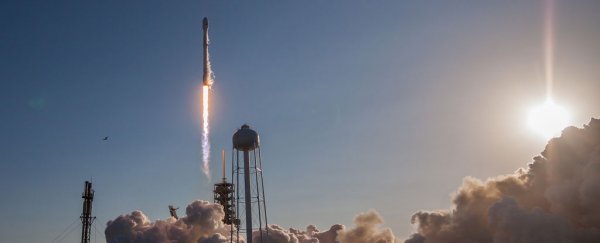SpaceX made history last week, launching a pre-flown booster into space for the first time ever – arguably the strongest milestone yet in the company's bid to make economical, reusable rockets.
The achievement – which SpaceX chief Elon Musk hailed as a "revolution" – could come to be seen as the beginning of a new chapter in human exploration, in which rocket launches become dramatically cheaper and space becomes more accessible.
"I think it's an amazing day for space," Musk said after the launch in a video message. "It means you can fly and re-fly an orbit-class booster, which is the most expensive part of the rocket. This is going to be, hopefully, a huge revolution in spaceflight."
Reusability has long been a central component of SpaceX's vision, with the company describing the principle as "the key to making human life multi-planetary", by virtue of its ability to cut the costs associated with rocket launches.
Of course, the first step in making rockets reusable is getting them to land after they've flown – something which SpaceX appears to have gotten the hang of both on land and on floating sea platforms – although it took some highly publicised failures to perfect the technique.
Now, with last Thursday's success, one of the company's pre-flown and landed Falcon 9 booster rockets launched off for a second mission from Kennedy Space Centre in Florida.
After deploying a telecommunications satellite into orbit, it then returned to Earth and made a successful landing on a drone platform floating in the Atlantic Ocean – a convincing demonstration that the end-to-end reusable rocket cycle is actually possible.
"It did this mission perfectly," Musk said. "It dropped off the second stage, came back and landed on the drone ship. Right in the bulls-eye."
Before this modern era of reusable rockets as demonstrated by SpaceX and Jeff Bezos' Blue Origin, all previous rocket launches were one-off affairs, resulting in the destruction of the rocket's booster.
Given a Falcon 9 is said to cost more than $61 million to build, the financial advantages of reusing the machinery quickly start to add up.
And when you consider that Musk has said the rockets might ultimately be re-deployed hundreds of times – potentially re-launching within 24 hours of having landed – it starts to make sense that we could be looking at a whole new kind of spaceflight here.
Not only in terms of SpaceX, either – but potentially the whole spaceflight industry. As Musk explained at a news conference after the launch and landing:
"I think, hopefully, this will inform the decisions of other space organisations. Reusability has been put forth as really too hard, or not really feasible. Now, in order to be competitive in launch costs, I think it's going to be necessary for other companies to do the same thing.
Imagine if we were an aircraft company selling aircraft that could be flown many times, and everyone else was selling aircraft that could be flown once, I mean, you know, that's not a very competitive position to be in."
In that sense, the greater significance of a moment like this isn't just that we now know reusable rockets are technologically feasible – but that they become the new norm, much like the introduction of the modern commercial airliner in the 1950s and '60s.
"I think that 50 years from now we'll look back on this day and that's say where commercial space travel began," aerospace engineer and former NASA chief technologist Bobby Braun told Eric Berger at Ars Technica.
Beyond lowering the cost and format of rocket flights across the board, the era of proven reusable, relaunchable boosters also means that, in the future, we'll be able to take off from places we've landed.
In the context of travel to other planets – with Mars as the first destination – the significance of that can't be understated for humanity's pioneering astronauts.
"No one has ever done anything like this before," SpaceX CEO Gwynne Shotwell said in a video broadcast before the launch.
"We're not [a] one-way trip to Mars, people. We want to make sure that whoever we take can come back."
